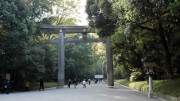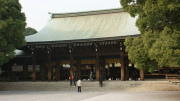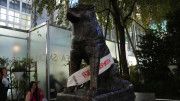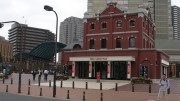The Shibuya district surrounds the Shibuya Railway Station, this station is known as one of the busiest stations in the world. An estimated 2.4 million people pass through Shibuya’s turnstiles every weekday. But Shibuya isn’t Tokyo’s busiest station; Tokyo, Shinjuku and Ikebukuro incredibly usually handle more.
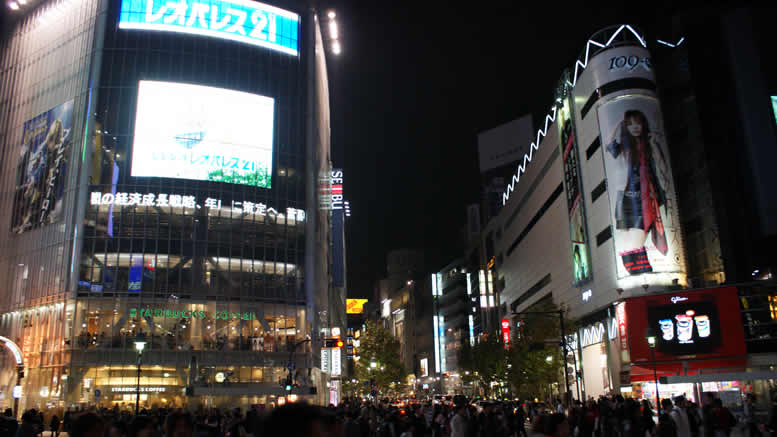
One of the more recognisable images of Tokyo would have to be the incredibly busy scramble intersection outside Shibya Station. This huge four way crossroad is the gateway to Center Gai; the shopping district of Shibya. The intersection has been used extensively in advertising, and more recently films like Lost in Translation and Fast and the Furious, Tokyo Drift. All taking advantage of the amazing spectacle of the intersection and massive neon and video screen building facades.
As well as the sights of neon and video, there is the sound of blaring J-Pop, which deafens the four intersecting roads of traffic. If the amount of people, traffic and blinding video walls don’t disorient you, the blaring J-Pop certainly will. Several of the screens pump out J-Pop advertising trying to drown each other out. Crossing the intersection is an amazing experience and feat in its self, as people head in all directions across the huge zebra crossings.
For a calmer moment, there is a quaint little square in front of the Shibuya Station overlooking the Centre Gai intersection. The square is known as Hachiko Square; it was named after a famous dog who has become an urban legend of Shibuya. It is said that Hachiko returned to the same spot every day waiting for his master to return to the station from work, but sadly one day his master didn’t return after passing away at work. The dog faithfully returned back to the station every day waiting for his master to return. The dog became a celebrity as the story of his faithfulness grew. Today, Hachiko and his legend are remembered by a statue of the hound which sits proudly in the park, close to where he waited so patiently for all those years. The statue has become a popular symbol of Shibuya Station and its surrounds and is a popular meeting place. The area in front of Hachiko’s statue was even used as a stop on a recent episode of the television series, The Amazing Race.
Across the road from the station is a street known as Center Gai; although only 400 or so meters long, it is an area jam packed with shopping and entertainment including karaoke, pachinko, cafes, bars and restaurants. The short strip is very busy, especially in the evenings when people are out to have fun. It is amazing how much can be packed into a small strip; many of the shops, cafes and entertainment venues are several floors above ground level. These venues and can be found by long strip neon and video advertising running up the buildings.
Much of the shopping is targeted towards the youth market, so the latest fashions are big business here. Famous shopping complexes like Shibuya 109 and Seibu Department Store are very popular, so is Tokyu Hands. Tokyu Hands is a unique hardware come craft or gift shop selling everything from power tools to stationery and hand bags. Tokyo Hands can be found in several places around Japan, but the Shibuya store was the first and one of the largest with seven floors of shopping. Takashimaya is another of the big name department stores in the area and the Shibuya store is the company’s biggest.
To the west of the station is the area known as Dogenzaka. This huge entertainment area has hundreds of places to dine or drink plus plenty of pachinko parlours and other forms of entertainment. The area also features quite a few themed Love Hotels for that romantic night out with someone special.
Keon Dori is another popular shopping street and is home to the Marui department store. This street stretches to the Yoyogi National Stadium which was built for the 1964 Olympic Games. The parks surrounding the stadium are very popular for people watching, especially on Sundays when the young come to show off their exotic fashion and make up. The park is also a great place for up and coming J-Pop or rock bands to get noticed. The park is also very popular during the cherry blossom season.
Heading off Yoyogi Park is Takeshita Street in Harajuku. This street is a must for anyone who is interested in the weirder side of Japanese youth fashion. This long and thin lane is always crammed with thousands of shoppers and dozens of tiny fashion stores selling some of the more interesting youth culture costumes.
For people interested in culture, the Meiji Jingu Shrine is well worth a visit. If you are into high end fashion, check out Omotesando Avenue, a street that is home to many of Shibuya’s famous brand boutiques.
Shibuya Station serves several lines of the JR, Tokyo Metro, Tokyu and Keio railway companies. The most popular lines at this station would be JR’s Yamanote Line and the Tokyo Metro Ginza Line (G01). The Narita Express also stops here making for easy access to Narita Airport. Meanwhile, Yokohama is a bit over 30klm to the South West of Shibuya Station via the JR Shonan-Shinjuku Line.

